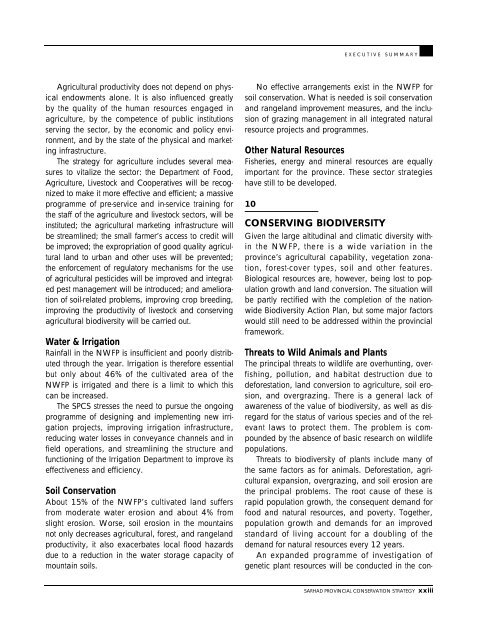Sarhad Provincial Conservation Strategy - IUCN
Sarhad Provincial Conservation Strategy - IUCN
Sarhad Provincial Conservation Strategy - IUCN
Create successful ePaper yourself
Turn your PDF publications into a flip-book with our unique Google optimized e-Paper software.
Agricultural productivity does not depend on physical<br />
endowments alone. It is also influenced greatly<br />
by the quality of the human resources engaged in<br />
agriculture, by the competence of public institutions<br />
serving the sector, by the economic and policy environment,<br />
and by the state of the physical and marketing<br />
infrastructure.<br />
The strategy for agriculture includes several measures<br />
to vitalize the sector: the Department of Food,<br />
Agriculture, Livestock and Cooperatives will be recognized<br />
to make it more effective and efficient; a massive<br />
programme of pre-service and in-service training for<br />
the staff of the agriculture and livestock sectors, will be<br />
instituted; the agricultural marketing infrastructure will<br />
be streamlined; the small farmer’s access to credit will<br />
be improved; the expropriation of good quality agricultural<br />
land to urban and other uses will be prevented;<br />
the enforcement of regulatory mechanisms for the use<br />
of agricultural pesticides will be improved and integrated<br />
pest management will be introduced; and amelioration<br />
of soil-related problems, improving crop breeding,<br />
improving the productivity of livestock and conserving<br />
agricultural biodiversity will be carried out.<br />
Water & Irrigation<br />
Rainfall in the NWFP is insufficient and poorly distributed<br />
through the year. Irrigation is therefore essential<br />
but only about 46% of the cultivated area of the<br />
NWFP is irrigated and there is a limit to which this<br />
can be increased.<br />
The SPCS stresses the need to pursue the ongoing<br />
programme of designing and implementing new irrigation<br />
projects, improving irrigation infrastructure,<br />
reducing water losses in conveyance channels and in<br />
field operations, and streamlining the structure and<br />
functioning of the Irrigation Department to improve its<br />
effectiveness and efficiency.<br />
Soil <strong>Conservation</strong><br />
About 15% of the NWFP’s cultivated land suffers<br />
from moderate water erosion and about 4% from<br />
slight erosion. Worse, soil erosion in the mountains<br />
not only decreases agricultural, forest, and rangeland<br />
productivity, it also exacerbates local flood hazards<br />
due to a reduction in the water storage capacity of<br />
mountain soils.<br />
No effective arrangements exist in the NWFP for<br />
soil conservation. What is needed is soil conservation<br />
and rangeland improvement measures, and the inclusion<br />
of grazing management in all integrated natural<br />
resource projects and programmes.<br />
Other Natural Resources<br />
Fisheries, energy and mineral resources are equally<br />
important for the province. These sector strategies<br />
have still to be developed.<br />
10<br />
E X E C U T I V E S U M M A R Y<br />
CONSERVING BIODIVERSITY<br />
Given the large altitudinal and climatic diversity within<br />
the NWFP, there is a wide variation in the<br />
province’s agricultural capability, vegetation zonation,<br />
forest-cover types, soil and other features.<br />
Biological resources are, however, being lost to population<br />
growth and land conversion. The situation will<br />
be partly rectified with the completion of the nationwide<br />
Biodiversity Action Plan, but some major factors<br />
would still need to be addressed within the provincial<br />
framework.<br />
Threats to Wild Animals and Plants<br />
The principal threats to wildlife are overhunting, overfishing,<br />
pollution, and habitat destruction due to<br />
deforestation, land conversion to agriculture, soil erosion,<br />
and overgrazing. There is a general lack of<br />
awareness of the value of biodiversity, as well as disregard<br />
for the status of various species and of the relevant<br />
laws to protect them. The problem is compounded<br />
by the absence of basic research on wildlife<br />
populations.<br />
Threats to biodiversity of plants include many of<br />
the same factors as for animals. Deforestation, agricultural<br />
expansion, overgrazing, and soil erosion are<br />
the principal problems. The root cause of these is<br />
rapid population growth, the consequent demand for<br />
food and natural resources, and poverty. Together,<br />
population growth and demands for an improved<br />
standard of living account for a doubling of the<br />
demand for natural resources every 12 years.<br />
An expanded programme of investigation of<br />
genetic plant resources will be conducted in the con-<br />
SARHAD PROVINCIAL CONSERVATION STRATEGY xxiii

















